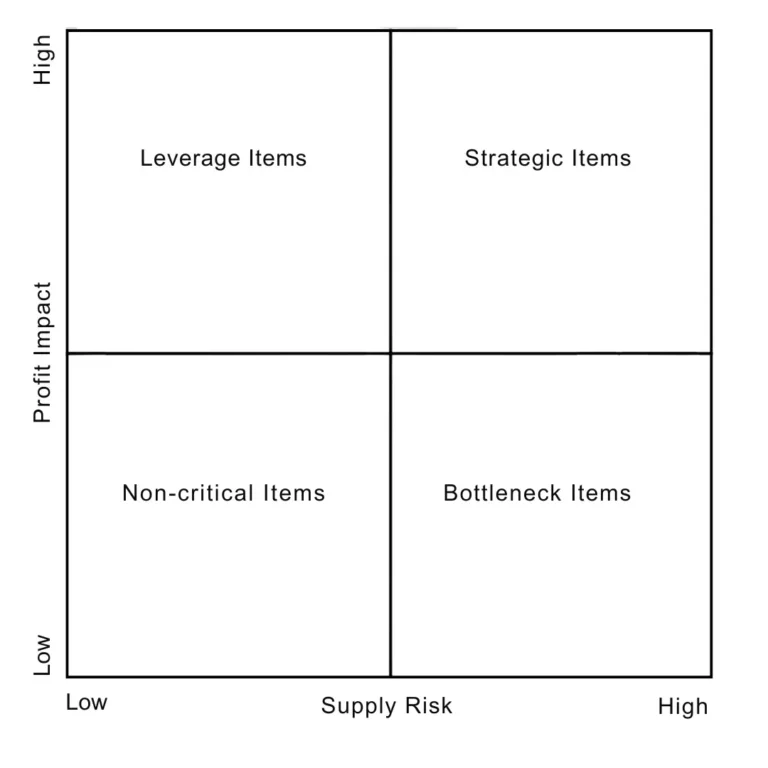| Key Takeaways |
|---|
| • Supplier segmentation groups vendors based on spend, risk, and strategic importance |
| • The Kraljic Matrix is an effective tool for advanced supplier segmentation |
| • Proper segmentation improves supplier relationships and reduces risks |
| • Data-driven analysis is essential for accurate supplier categorization |
| • Customized strategies for each segment optimize procurement resources and efficiency |
Supplier segmentation is a strategic process that involves categorizing suppliers based on specific criteria, allowing organizations to manage their supplier relationships more effectively. This approach recognizes that suppliers vary in their value, risk, or strategic importance to a company.
In procurement and supply chain management, supplier segmentation plays a key role in optimizing operations. By classifying suppliers into distinct groups, organizations can:
Implementing a robust supplier segmentation strategy offers several advantages:
Spend-based segmentation is a basic approach that categorizes suppliers based on the total amount of money an organization spends with them. This method aligns with the Pareto Principle, also known as the 80/20 rule, which suggests that approximately 20% of suppliers often account for 80% of an organization's total spend.
To implement spend-based segmentation:
It's important to not only look at current spend but also consider potential future growth:
Risk-based segmentation focuses on assessing the potential threats that suppliers pose to an organization's operations and reputation.
When evaluating supplier risks, consider:
After assessing risks, categorize suppliers accordingly:
By utilizing these segmentation methods, organizations can gain a comprehensive understanding of their supplier base and develop targeted strategies for each category.
The Kraljic Matrix is a sophisticated tool for supplier segmentation, plotting suppliers on a 2x2 matrix based on two key dimensions: supply risk and profit impact.
To use the Kraljic Matrix:
The Kraljic Matrix divides suppliers into four quadrants:

Effective supplier segmentation requires a systematic approach. Let's explore the steps to implement this strategic process in your organization.
The foundation of successful supplier segmentation lies in collecting comprehensive and accurate data. Key information to gather includes:
Once you have gathered the necessary data, the next step is to analyze it and categorize your suppliers accordingly.
For a more nuanced approach, plot your suppliers on the Kraljic Matrix:
With suppliers categorized, it's time to create targeted strategies for each segment.
For strategic suppliers:
For leveraged and bottleneck suppliers:
For non-critical suppliers:
By following these steps, you can create a robust supplier segmentation framework that aligns with your organization's goals and optimizes your procurement processes.
Implementing a well-structured supplier segmentation strategy can yield significant advantages for your organization. Let's explore the key benefits in detail.
Effective segmentation allows you to:
This targeted approach can lead to:
By categorizing suppliers based on risk factors, you can:
This proactive stance helps:
Supplier segmentation enables:
These efficiencies can result in:
With a clear understanding of supplier segments, you can:
This strategic allocation leads to:
Segmentation allows for:
By implementing bespoke strategies, you can:
Supplier segmentation is a powerful tool that can transform your procurement and supply chain management practices. By strategically categorizing suppliers based on spend, risk, and strategic importance, organizations can unlock significant value and drive operational excellence.
Throughout this article, we've explored the various aspects of supplier segmentation, from its fundamental principles to advanced techniques like the Kraljic Matrix. We've seen how effective segmentation can lead to improved supplier relationships, reduced risks, enhanced efficiency, and optimized resource allocation.
As procurement continues to evolve in an increasingly complex business landscape, the ability to segment and manage suppliers effectively will be a key differentiator for successful organizations. By implementing the strategies and best practices outlined in this article, you can position your company for success in the competitive world of procurement and supply chain management.
Ready to take your supplier management to the next level? Krinati Solutions offers cutting-edge eSourcing and eProcurement solutions that can help you implement robust supplier segmentation strategies. Our advanced supplier management tools are designed to streamline your processes and drive value across your supply chain.
Don't let the complexities of supplier management hold your organization back. Contact Krinati Solutions today to learn how our innovative solutions can help you harness the power of effective supplier segmentation and transform your procurement operations.